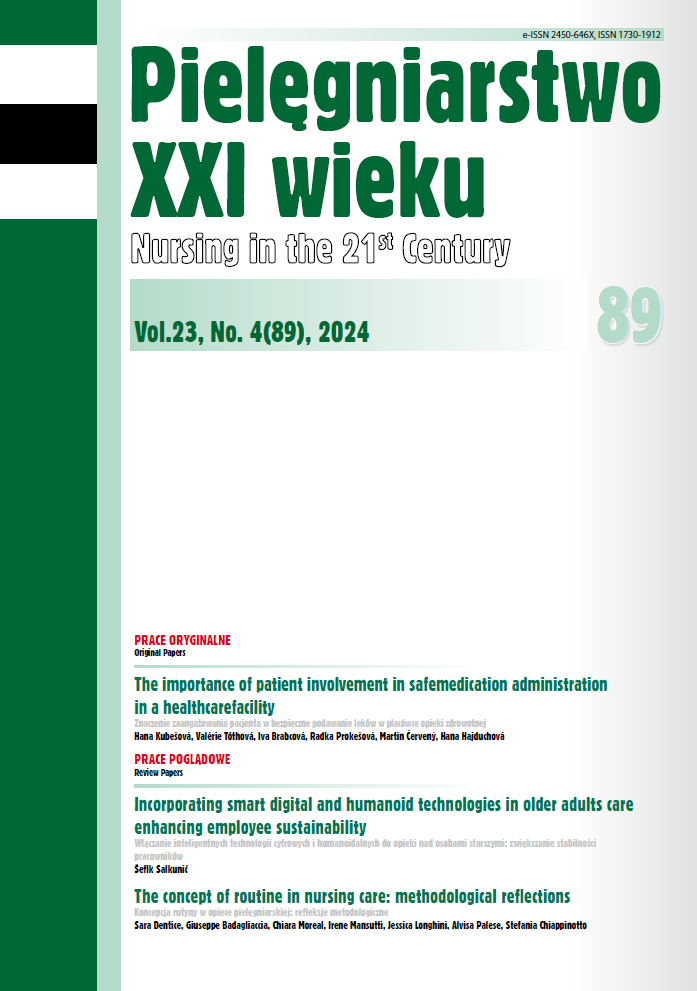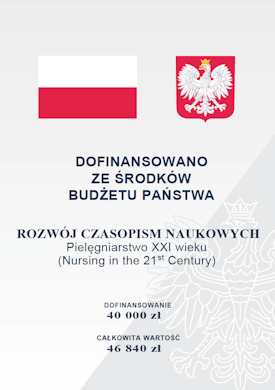Koncepcja rutyny w opiece pielęgniarskiej: refleksje metodologiczne
DOI:
https://doi.org/10.12923/pielxxiw-2024-0049Słowa kluczowe:
rutynowa opieka, zwykła opieka, standard opieki, praktyka pielęgniarskaAbstrakt
KONCEPCJA RUTYNY W OPIECE PIELĘGNIARSKIEJ: REFLEKSJE METODOLOGICZNE
Wprowadzenie. Rutyna jest zjawiskiem powszechnym w praktyce pielęgniarskiej. Choć często postrzegana jako powtarzalna, jest niezbędna do zapewnienia skuteczności i spójności w świadczeniu opieki zdrowotnej. Rola rutyny jest złożona, gdyż balansuje pomiędzy gwarantowaniem pewnej struktury a utrudnianiem zapewniania spersonalizowanej opieki.
Cel pracy. Niniejszy artykuł bada pojęcie rutyny w wielu dyscyplinach naukowych, w tym w socjologii, psychologii i badaniach organizacyjnych. Podkreśla także jej implikacje dla opieki zdrowotnej, pielęgniarstwa i badań naukowych.
Metody. Przegląd literatury.
Wnioski. Biorąc pod uwagę brak jasności pojęciowej jeśli chodzi o koncept rutyny, co może wpływać na rozwój pielęgniarstwa, zaproponowano zalecenia dotyczące dalszych badań.
Bibliografia
1. Treccani [Internet]. [cited 2024 Apr 12]. routine - Treccani. Available from: https://www.treccani.it/vocabolario/routine/, https://www.treccani.it/vocabolario/routine/
2. Thesaurus.com [Internet]. 2024 [cited 2024 Apr 13]. Thesaurus.com - The world’sfavorite online thesaurus! Available from: https://www.thesaurus.com/browse/routine
3. Arlinghaus KR, Johnston CA. The importance of creating habits and routine. Am. J. Lifestyle Med. 2019; 13(2): 142-144.
4. Fiese BH, Tomcho TJ, Douglas M, et al. A review of 50 years of research on naturally occurring family routines and rituals: Cause for celebration? J. Fam. Psychol. 2002; 16(4): 381-390.
5. Rytterstrom P, Unosson M, Arman M. The signifi cance of routines in nursing practice. J. Clin. Nurs. 2011; 20(23-24): 3513-3522.
6. Zisberg A, Young HM, Schepp K, et al. A concept analysis of routine: relevance to nursing. J. Adv. Nurs. 2007; 57(4): 442-453.
7. Herrera CA, Juarez-Ramirez C, Reyes-Morales H, et al. COVID-19 disruption to routine health care services: How 8 Latin American and Caribbean Countries responded. Health Aff Proj. Hope. 2023; 42(12): 1667-1674.
8. Daly A, Teeling SP, Garvey S, et al. Using a combined lean and person-centred approach to support the resumption of routine hospital activity following the fi rst wave of COVID-19. Int. J. Environ. Res. Public Health. 2022; 19(5): 2754.
9. Delpino FM, da Silva CN, Jeronimo JS, et al. Prevalence of anxiety during the COVID-19 pandemic: A systematic review and meta-analysis of over 2 million people. J. Aff ect. Disord. 2022; 318: 272-282.
10. Gonella S, Di Giulio P, Palese A, et al. Randomized controlled trials and quasiexperimental studies published in nursing journals: fi ndings from a scoping review with implications for further research. Worldviews Evid Based Nurs. 2019; 16(4): 299-309.
11. McKinnon A. Ritual. In: Turner BS, editor. The Wiley‐Blackwell Encyclopedia of Social Theory [Internet]. 1st ed. Wiley; 2017 [cited 2024 Apr 13]. p. 1–2. Available from: https://onlinelibrary.wiley.com/doi/10.1002/9781118430873.est0318
12. Boyer P, Lienard P. Ingredients of ‘rituals’ and their cognitive underpinnings. Philos. Trans. R. Soc. Biol. Sci. 2020; 375(1805): 20190439.
13. Spagnola M, Fiese BH. Family routines and rituals: a context for development in the lives of young children. Infants Young Child. 2007; 20(4): 284-299.
14. Migliorini L, Rania N, Tassara T, et al. Family routine behaviors and meaningful rituals: a comparison between italian and migrant couples. Soc. Behav. Personal. Int. J. 2016; 44(1): 9-18.
15. Wood W, Runger D. Psychology of habit. Annu. Rev. Psychol. 2016; 67(1): 289-314.
16. Mazar A, Wood W. Defi ning Habit in Psychology. In: Verplanken B, editor. The Psychology of Habit [Internet]. Cham: Springer International Publishing; 2018 [cited 2024 Apr 13]. p. 13-29. Available from: http://link.springer.com/10.1007/978-3-319-97529-0_2
17. Lally P, Van Jaarsveld CHM, Potts HWW, et al. How are habits formed: Modelling habit formation in the real world. Eur. J. Soc. Psychol. 2010; 40(6): 998-1009.
18. Hagger MS. Habit and physical activity: Theoretical advances, practical implications, and agenda for future research. Psychol. Sport Exerc. 2019; 42: 118-129.
19. Trafi mow D. The Automaticity of Habitual Behaviours: Inconvenient Questions. In: Verplanken B, editor. The Psychology of Habit [Internet]. Cham: Springer International Publishing; 2018 [cited 2024 Apr 13]. p. 379-395. Available from: http://link.springer.com/10.1007/978-3-319-97529-0_21
20. Feldman MS, Pentland BT. Reconceptualizing organizational routines as a source of fl exibility and change. Adm. Sci. Q. 2003; 48(1): 94-118.
21. Becker MC, Zirpoli F. Applying organizational routines in analyzing the behavior of organizations. J. Econ. Behav. Organ. 2008; 66(1): 128-148.
22. Pentland BT. Organizational routines as a unit of analysis. Ind. Corp. Change. 2005; 14(5): 793-815.
23. Feldman MS. Organizational routines as a source of continuous change. Organ Sci. 2000; 11(6): 611-629.
24. Wolthuis F, Hubers MD, Van Veen K, et al. The concept of organizational routines and its potential for investigating educational initiatives in practice: a systematic review of the literature. Rev. Educ. Res. 2022; 92(2): 249-287.
25. Pentland BT, Harem T. Organizational routines as patterns of action: implications for organizational behavior. Annu. Rev. Organ. Psychol. Organ. Behav. 2015 Apr 10;2(1):465-87.
26. Almatrodi I, Skoumpopoulou D. Organizational routines and digital transformation: an analysis of how organizational routines impact digital transformation transition in a Saudi University. Systems. 2023; 11(5): 239.
27. Cooke BK, Worsham E, Reisfield GM. The elusive standard of care. J. Am. Acad. Psychiatry Law. 2017; 45(3): 358-364.
28. Vanderpool D. The Standard of Care. Innov. Clin. Neurosci. 2021; 18(7-9): 50-51.
29. WHO Guidelines for Safe Surgery 2009: Safe Surgery Saves Lives [Internet]. Geneva: World Health Organization; 2009 [cited 2024 Apr 13]. (WHO Guidelines Approved by the Guidelines Review Committee). Available from: http://www.ncbi.nlm.nih.gov/books/NBK143243/
30. Hazlehurst B, McMullen C. Orienting frames and private routines: The role of cultural process in critical care safety. Int. J. Med. Inf. 2007; 76: S129-135.
31. Leep‐Lazar K, Stimpfel AW. A dimensional analysis of nursing unit culture. J. Adv. Nurs. 2023 Nov 22; jan.15985.
32. Pearcey P. Tasks and routines in 21st century nursing: student nurses’ perceptions. Br. J. Nurs. Mark. Allen. Publ. 2007; 16(5): 296-300.
33. Phuthornchai K, Banharak S, Panpanit L, et al. Effects of symptom management program on selected health outcomes among older people with chronic obstructive pulmonary disease: a quasi-experimental study. Sci. Rep. 2023; 13(1): 22265.
34. Bowers BJ, Lauring C, Jacobson N. How nurses manage time and work in long‐term care. J. Adv. Nurs. 2001; 33(4): 484-491.
35. Willard C, Luker K. Challenges to end of life care in the acute hospital setting. Palliat. Med. 2006; 20(6): 611-615.
36. Levesque MH, Trepanier J, Sirois MJ, et al. Effets du Lifestyle Redesign chez les aines : une recension systematique. Can. J. Occup. Ther. 2019; 86(1): 48-60.
37. Pyatak EA, Carandang K, Rice Collins C, et al. Optimizing Occupations, Habits, and Routines for Health and Well-Being With Lifestyle RedesignR: A Synthesis and Scoping Review. Am. J. Occup. Ther. 2022; 76(5): 7605205050.
38. Equator Network. Reporting guidelines [Internet]. Available from: https://www.equator-network.org/reporting-guidelines/
39. Kosicka B, Ozdoba P, Dziurka M, et al. Experiential methods in ethical education of nursing and midwifery students. Pielęgniarstwo XXI Wieku. 2023; 22(3): 195-205. DOI: 10.2478/pielxxiw-2023-0024
40. Black K, Lobo M. A conceptual review of family resilience factors. J. Fam. Nurs. 2008; 14(1): 33-55.
41. Standard - Treccani - Treccani [Internet]. [cited 2024 May 3]. Available from: https://www.treccani.it/vocabolario/ricerca/standard/
42. Definition of standard of care - NCI Dictionary of Cancer Terms - NCI [Internet]. 2011 [cited 2024 May 3]. Available from: https://www.cancer.gov/publications/dictionaries/cancer-terms/def/standard-of-care
43. Treccani [Internet]. [cited 2024 May 3]. abituale - Treccani. Available from: https://www.treccani.it/vocabolario/ricerca/abituale/
44. Turner KM, Huntley A, Yardley T, et al. Defining usual care comparators when designing pragmatic trials of complex health interventions: a methodology review. Trials. 2024; 25(1): 117.
45. Page MJ, McKenzie JE, Bossuyt PM, et al. The PRISMA 2020 statement: an updated guideline for reporting systematic reviews. BMJ [Internet]. 2021 Mar 29 [cited 2024 Feb 14];n71. Available from: https://www.bmj.com/lookup/doi/10.1136/bmj.n71
46. Cochrane Handbook for Systematic Reviews of Interventions. Version 6.2 (updated February 2021). Cochrane Collaboration; 2021. Available from: https://training.cochrane.org/handbook
47. Schulz KF, Altman DG, Moher D, et al. CONSORT 2010 statement: updated guidelines for reporting parallel group randomised trials. BMJ. 2010 Mar 23;340:c332. doi: 10.1136/bmj.c332. PMID: 20332509; PMCID: PMC2844940.
48. Zwarenstein M, Treweek S, Gagnier JJ, et al. Improving the reporting of pragmatic trials: an extension of the CONSORT statement. BMJ. 2008 Nov 11;337:a2390. doi: 10.1136/bmj.a2390. PMID: 19001484; PMCID: PMC3266844.
49. Hemming K, Taljaard M, McKenzie JE, et al. Reporting of stepped wedge cluster randomised trials: extension of the CONSORT 2010 statement with explanation and elaboration. BMJ. 2018 Nov 9;363:k1614. doi: 10.1136/bmj.k1614. PMID: 30413417; PMCID: PMC6225589.
50. De Geest S, Zullig LL, Dunbar-Jacob J, Hughes D, Wilson IB, Vrijens B. Improving medication adherence research reporting: ESPACOMP Medication Adherence Reporting Guideline (EMERGE). Eur J Cardiovasc Nurs. 2019 Apr;18(4):258-259. doi:10.1177/1474515119830298. Epub 2019 Feb 10. PMID: 30739497; PMCID: PMC6433491.
51. Hoffmann TC, Glasziou PP, Boutron I, et al. Better reporting of interventions: template for intervention description and replication (TIDieR) checklist and guide. BMJ. 2014 Mar 7;348:g1687. doi: 10.1136/bmj.g1687. PMID: 24609605.
52. Duncan E, O’Cathain A, Rousseau N, et al. Guidance for reporting intervention development studies in health research (GUIDED): an evidence-based consensus study. BMJ Open. 2020;10. doi:10.1136/bmjopen-2019-033516.
53. Ogrinc G, Davies L, Goodman D, et al. SQUIRE 2.0 (Standards for QUality Improvement Reporting Excellence): revised publication guidelines from a detailed consensus process. BMJ Qual Saf. 2016 Dec;25(12):986-992. doi: 10.1136/bmjqs-2015-004411. Epub 2015 Sep 14. PMID: 26369893; PMCID: PMC5256233.
54. Pinnock H, Barwick M, Carpenter CR, et al. Standards for Reporting Implementation Studies (StaRI) Statement. BMJ. 2017 Mar 6;356:i6795. doi: 10.1136/bmj.i6795. PMID: 28264797; PMCID: PMC5421438.
55. Bossuyt PM, Reitsma JB, Bruns DE, et al. STARD 2015: an updated list of essential items for reporting diagnostic accuracy studies. BMJ. 2015 Oct 28;351:h5527. doi: 10.1136/bmj.h5527. PMID: 26511519; PMCID: PMC4623764.
56. von Elm E, Altman DG, Egger M, et al. The Strengthening the Reporting of Observational Studies in Epidemiology (STROBE) Statement: guidelines for reporting observational studies. Int. J. Surg. 2014 Dec;12(12):1495-9. doi: 10.1016/j.ijsu.2014.07.013. Epub 2014 Jul 18. PMID: 25046131.
Pobrania
Opublikowane
Numer
Dział
Licencja
Prawa autorskie (c) 2025 Autorzy

Utwór dostępny jest na licencji Creative Commons Uznanie autorstwa 4.0 Międzynarodowe.




